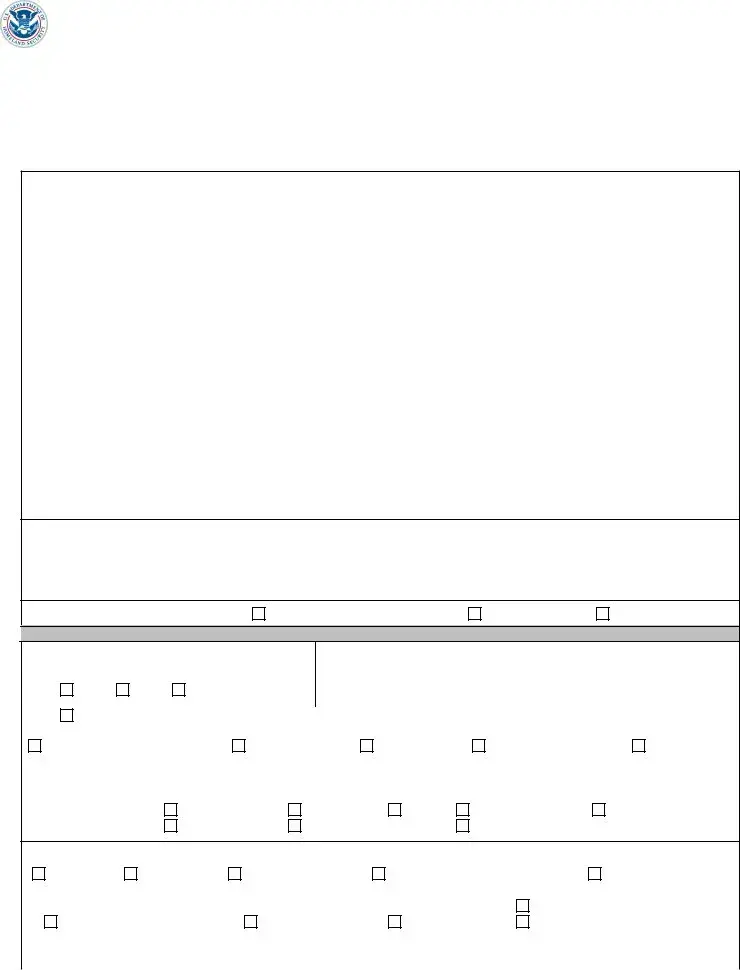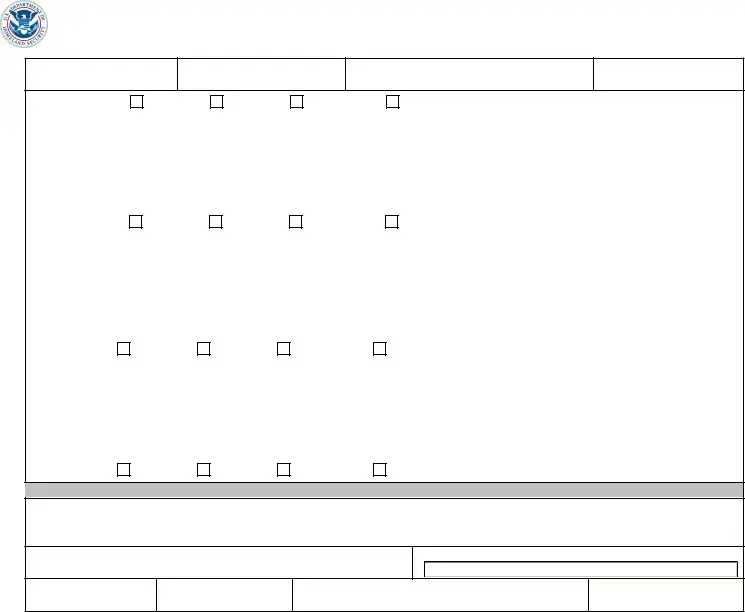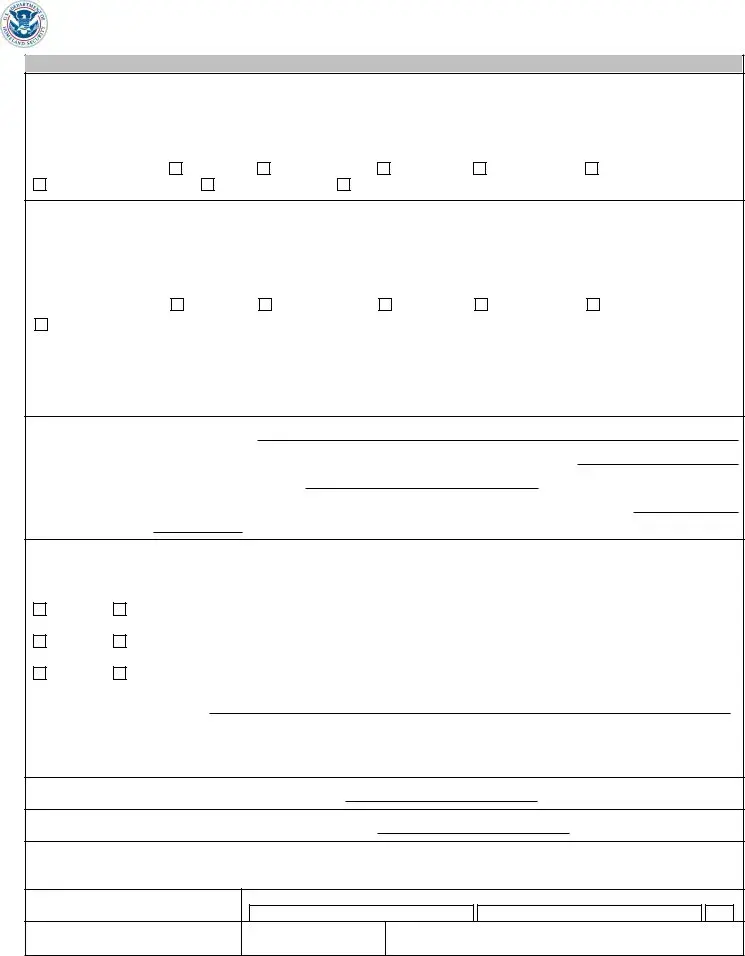DEPARTMENT OF HOMELAND SECURITY
U.S. Customs and Border Protection
CREATE/UPDATE IMPORTER IDENTITY FORM
19 CFR 24.5
OMB APPROVAL NO. 1651-0064 EXPIRATION DATE 12-31-2020
As the importer, consignee, or other party listed in block 1, you are responsible for the validity of the information provided in this document. Any Customs Broker or third party who is submitting the information on your behalf is only obligated to convey this information to Customs and Border Protection (CBP).
PRIVACY ACT STATEMENT: Pursuant to 5 U.S.C. § 552a(e)(3), this Privacy Act Statement serves to inform you of why DHS is requesting the information on this form.
AUTHORITY: The U.S. Customs and Border Protection (CBP) is authorized to collect the information requested on this form pursuant to Title 19 of the Code of Federal Regulations (19 CFR §24.5 Filing Identification Number and 149.3 Data Elements). CBP has the authority to collect Social Security numbers (SSN) under Executive Order (E.O.) 9397, as amended by E.O. 13478 (Pursuant to 31 U.S.C. §7701(c), 26 U.S.C. §6109(d), 19 C.F.R. §24.5 and §149.3).
PURPOSE: CBP is requesting this information to collect and maintain records on all commercial goods imported into the United States, along with carrier, broker, importer, and other ACE-ITDS Portal user account and manifest information. CBP will use this information to track, control, and process all commercial goods imported into the United States. This facilitates the flow of legitimate shipments, and assists the Department of Homeland (DHS)/CBP in targeting illicit goods.
ROUTINE USES: The information requested on this form may be shared externally, as a “routine use” with appropriate federal, state, local, tribal, or foreign governmental agencies, or multilateral governmental organizations, to assist DHS in investigating or prosecuting the violations of, or for enforcing or implementing, a statute, rule, regulation, order, license, or treaty or when DHS determines that the information would assist in the enforcement of civil or criminal laws. A complete list of the routine uses can be found in the system of records notice associated with this form, “DHS/CBP-001 Import Information System.” The Department's full list of system of records notices can be found on the Department's website at https://www.dhs.gov/system-records-notices-sorns.
CONSEQUENCES OF FAILURE TO PROVIDE INFORMATION: Providing this information to is voluntary. However, failure to provide the information will result in the denial of a CBP-assigned importer number/importer of record identification (ID) number, and inability to pay import related duties, taxes, and fees related to an entry of imported goods. Individuals who do not provide this information may be required to use a separate party for transactions, which may affect or delay the importation of shipments in international trade.
PAPERWORK REDUCTION ACT STATEMENT: An agency may not conduct or sponsor an information collection and a person is not required to respond to this information unless it displays a current valid OMB control number and an expiration date. The control number for this collection is 1651-0064. The estimated average time to complete this application is 45 minutes. The obligation to respond is required to obtain a benefit. If you have any comments regarding the burden estimate you can write to U.S. Customs and Border Protection, Office of International Trade, Regulations and Rulings, 90 K Street NE, Washington DC 20229-1177.
TYPE OF ACTION (Mark all applicable): |
Notification of identification number |
Change of name* |
Change of address* |
1. NAME AND IDENTIFICATION NUMBER
*1A. Importer/Business/Private Party Name: 1B. Internal Revenue Service (IRS) number/Social Security Number (SSN):
1C. |
DIV |
AKA |
DBA |
1D. DIV/AKA/DBA Name: |
|
|
|
*1E. |
I wish to be assigned a CBP Number. Check here if requesting a CBP-assigned number and indicate reason(s). |
|
Check all reasons that apply. |
|
I have a SSN, but wish to use a |
I have no Social |
I have no IRS |
I have not applied for |
|
I am not a |
CBP-Assigned Number on all my |
Security Number |
Number |
an IRS number or SSN |
U.S. Resident |
entry documents |
|
|
|
|
|
|
|
1F. CBP-Assigned Number: |
|
|
|
|
|
|
|
1G. Type of Company: |
Corporation |
|
Partnership |
LLC |
Sole Proprietorship |
Individual |
|
U.S. Government |
State/Local Government |
Foreign Government |
|
|
1H. If you are an importer, how many entries do you plan on filing in a year? Please select from the following:
1-4 per year |
5-24 per year |
25 or more per year |
infrequent personal shipments, or |
I do not intend to import. |
|
|
|
1I. How will the identification number be utilized? Please select all options that will apply: |
Importer of Record |
Consignee/Ultimate Consignee |
Drawback Claimant |
Refunds/Bills, or |
Other |
|
|
|
|
|
|
|
|
|
|
|
1J. Program Code 1: |
|
1K. Program Code 2: |
1L. Program Code 3: |
|
1M. Program Code 4: |
|
|
|
|
|
|
|
|
|
CBP Form 5106 (6/19) |
Page 1 of 3 |

2.ADDRESS INFORMATION 2A. MAILING ADDRESS (Each street address line can be no more than 32 characters)
*Street Address 1: |
|
|
*City: |
|
|
|
|
*State/Province: |
|
|
|
|
|
|
|
|
----Please Select--- |
|
|
|
|
|
|
|
|
|
|
|
Street Address 2: |
|
|
Zip Code: |
|
|
Country ISO Code: |
|
|
|
|
|
|
|
|
|
|
|
*Is the address in 2A, a |
Residence |
Corporate Office |
Warehouse |
Retail Location |
|
Office Building |
Business Service Center |
Post Office Box or |
Other - Explain: |
|
|
|
|
|
|
2B. PHYSICAL LOCATION ADDRESS (Required only if different than mailing address. 32 character limit applies to street address line)
|
*Street Address 1: |
|
|
|
*City: |
|
|
|
|
*State/Province: |
|
|
|
|
|
|
|
|
|
|
|
----Please Select--- |
|
|
|
|
|
|
|
|
|
|
|
|
|
|
Street Address 2: |
|
|
|
Zip Code: |
|
|
Country ISO Code: |
|
|
|
|
|
|
|
|
|
|
*Is the address in 2B, a |
Residence |
Corporate Office |
Warehouse |
Retail Location |
|
Office Building or |
|
Other - Explain: |
|
|
|
|
|
|
|
|
|
|
|
|
|
|
|
|
|
|
|
|
|
|
|
|
2C. *Phone number: |
|
Extension: |
|
2D. Fax number: |
|
|
|
|
|
|
|
|
|
|
|
|
|
|
|
|
|
2E. *Email address: |
|
|
|
2F. Website: |
|
|
|
|
|
|
|
|
|
|
|
|
|
|
|
|
|
|
|
|
|
|
3. COMPANY INFORMATION |
|
|
|
|
|
3A. Provide a brief business description:
3B. Provide the 6-digit North American Industry Classification System (NAICS) code for this business:
3C. Provide the D-U-N-S Number for the Importer:
3D. If you are also a broker/self-filer, supply the filer code that will be used when conducting business with CBP:
3E. Year established:
3F. List the names and Internal Revenue Service (IRS) employer identification, Social Security or CBP-assigned numbers for current or previous related business entities.
Related Business |
Name of Business Entities |
IRS/SSN/CBP-Assigned Number |
Current |
Previous |
|
|
|
|
|
|
Current |
Previous |
|
|
|
|
|
|
Current |
Previous |
|
|
|
|
|
|
3G. Primary Banking Institution:
(Name)
|
|
|
|
----Please Select--- |
|
|
(Bank Routing Number) |
|
(City) |
|
(State) |
|
(Country ISO Code) |
3H. Certificate or Articles of Incorporation - (Locater I.D.)
3I. Certificate or Articles of Incorporation – (Reference Number)
3J. Business Structure/Beneficial Owner/Company Officers - The officers listed in this section must have importing and financial business knowledge of the company listed in section 1 of this form and must have legal authority to make decisions on behalf of the company listed in section 1. Elements designated below with an asterisk are optional data fields.
Company Position Title:
Direct Phone Number:
Name (Last, First, Middle Initial):
CBP Form 5106 (6/19) |
Page 2 of 3 |
Country of Issuance:
---Please Select---
Passport Expiration Date:
Passport Type: |
Regular |
|
Official |
Diplomatic |
|
Passport Card |
|
|
|
|
|
|
|
|
|
|
|
|
|
|
|
|
|
|
|
|
|
|
|
|
|
|
|
|
|
|
|
Company Position Title: |
|
|
|
|
|
|
|
Name (Last, First, Middle Initial): |
|
|
|
|
|
|
|
|
|
|
|
|
|
|
|
|
|
|
|
|
|
|
|
|
|
|
|
|
|
|
|
|
|
|
|
Direct Phone Number: |
|
|
|
|
|
|
|
Extension: |
|
Direct Email: |
|
|
|
|
|
|
|
|
|
|
|
|
|
|
|
|
|
|
|
|
|
|
|
|
|
|
|
|
|
|
|
|
|
|
Social Security Number: |
|
Passport |
Number: |
|
|
Country |
of Issuance: |
|
Passport Expiration Date: |
|
|
|
|
|
|
|
|
|
|
|
|
|
---Please Select--- |
|
|
|
|
|
|
|
|
*Passport Type: |
Regular |
|
Official |
Diplomatic |
|
Passport Card |
|
|
|
|
|
|
|
|
|
|
|
|
|
|
|
|
|
|
|
|
|
|
|
Company Position Title: |
|
|
|
|
|
Name (Last, First, Middle Initial): |
|
|
|
|
|
|
|
|
|
|
|
|
|
|
|
|
|
|
|
|
|
|
|
|
|
|
|
|
|
|
|
|
|
|
|
|
Direct Phone Number: |
|
|
|
|
|
Extension: |
|
|
|
Direct Email: |
|
|
|
|
|
|
|
|
|
|
|
|
|
|
|
|
|
|
|
|
|
|
Social Security Number: |
|
Passport Number: |
|
Country of Issuance: |
Passport Expiration Date: |
|
|
|
|
|
|
|
|
|
|
|
|
---Please Select--- |
|
|
|
|
|
|
|
|
Passport Type: |
Regular |
Official |
Diplomatic |
|
Passport Card |
|
|
|
|
|
|
|
|
|
|
|
|
|
|
|
|
|
|
|
|
|
|
|
|
|
|
|
|
Company Position Title: |
|
|
|
|
|
Name (Last, First, Middle Initial): |
|
|
|
|
|
|
|
|
|
|
|
|
|
|
|
|
|
|
|
|
|
|
|
|
|
|
|
|
|
|
|
|
|
Direct Phone Number: |
|
|
|
|
|
Extension: |
|
|
|
Direct Email: |
|
|
|
|
|
|
|
|
|
|
|
|
|
|
|
|
|
|
|
|
|
|
|
|
|
|
|
Social Security Number: |
|
Passport Number: |
|
Country |
of Issuance: |
Passport Expiration Date: |
|
|
|
|
|
|
|
|
|
|
|
|
---Please Select--- |
|
|
|
|
|
|
|
|
Passport Type: |
Regular |
Official |
Diplomatic |
|
Passport Card |
|
|
|
|
|
|
|
|
4. CERTIFICATION
By my signature below, I certify that, to the best of my knowledge and belief, all of the information included in this document is true, correct, and provided in good faith. I understand that if I make an intentional false statement, or commit deception or fraud in this 5106 document, I may be fined or imprisoned (18 U.S.C. § 1001).
*Printed or Typed Full Name and Title:
Telephone Number: *Date:
CBP Form 5106 (6/19) |
Page 3 of 3 |
INSTRUCTIONS
TYPE OF ACTION
Notification of Identification Number - Check this box if this is your first request for services with CBP, or if your current Importer Number is inactive and you wish to activate this number.
Change Name - Check this box if the Importer Number is on file but there is a change in the name.
Change of Address - Check this box if the Importer Number is on file but there is a change in the address.
For updates involving changes to an existing IOR other than a “Change of Name” and “Change of Address”, the “TYPE OF ACTION” should be left blank.
NOTE - If a “Change of Address” and/or “Change of Name” is requested for an importer or other party that has an active bond on file with CBP, then a name and/or address rider must accompany this change document, unless the rider is otherwise not required for the bond pursuant to a CBP test announced in the Federal Register, such as CBP's eBond Test Program, or otherwise not required by CBP's regulations.
SECTION 1 - NAME AND IDENTIFICATION NUMBER
1A - Importer/Business/Private Name - Please indicate the name of the company or individual who will be importing or seeking service or payment. If you are submitting this document as a consignee to the import transaction, sections 1 and 2 must be filled out completely.
1B - IRS/SSN - Complete this block if you are assigned an Internal Revenue Service (IRS) employer identification number or Social Security Number (SSN). If neither an IRS employer identification number nor a Social Security Number (SSN) has been assigned, the word “NONE” shall be written in 1B. The SSN should belong to the principal or owner of the company.
1C - DIV/AKA/DBA - Complete this block if an importer is a division of another company (DIV), is also known under another name (AKA), or conducts business under another name (DBA).
1D - Complete this block only if Block 1C is used.
1E - Request CBP-Assigned Number - Complete this block if you have neither an IRS employer identification number nor a SSN and you require a CBP-assigned number, or, you choose to use a CBP-assigned number in lieu of your SSN. If you have an IRS employer identification number at the time you submit this form that number will automatically become your importer identification number and no CBP-assigned number will be issued.
PLEASE NOTE: A CBP-assigned number is for CBP use only and does not replace listing a SSN or IRS employer identification number on this form. If you have elected to request a CBP-Assigned Number in lieu of your SSN, you must provide your “Company Position Title”, name, and SSN in Block
3J of this form. If you have elected to request a CBP Assigned Number in lieu of your SSN, you must provide your SSN in section 3J of this form. In general, a CBP- assigned number will be issued to foreign businesses or individuals, provided no IRS employer identification number or SSN exists for the requester. A requester can choose to keep using the CBP-assigned number even if the individual subsequently acquires a SSN. If block 1E is completed, CBP will issue an assigned number and inform the requester. This identification number will be used for all future CBP transactions when an identification number is required. If an IRS employer identification number, a Social Security Number, or both, are obtained after an identification number has been assigned by CBP, a new CBP Form 5106 form shall not be filed unless requested by CBP.
1F - CBP-Assigned Number - Complete this block if you have already been assigned a CBP-Assigned Number, and there is a requested change in Block "Type of Action".
1G - Type of Company- Please select the description that accurately describes your company. A Limited Liability Company (LLC) is not a corporation; it is a legal form of company that provides limited liability to its owners.
1H - Provide an estimate of the number of entries that will be imported into the U.S. in one year, if you are an importer of record.
1I - Check the boxes which will indicate how the name and identification number will be utilized. If the role of the party is not listed, you can select “Other” and then list the specific role for the party. (ex., Transportation carrier, Licensed Customs Brokerage Firm, Container Freight Station, Commercial Warehouse/Foreign Trade Zone Operator, Container Examination Station or Deliver to Party).
1J thru 1M - If you are currently an active participant in a CBP Partnership Program(s), please provide the program code in Block 1J thru Block 1M of the revised CBP Form 5106 and the information that is contained in Section 3 of the revised CBP Form will not be required. (ex., Customs Trade Partnership Against Terrorism - CTPAT, Importer Self-Assessment - ISA)
SECTION 2 - ADDRESS INFORMATION
2A - MAILING ADDRESS (Mailing Address for the named business entity or individual referenced in section 1)
Street Address 1 - This block must always be completed. It may or may not be the physical location. Insert a post office box number or a street number representing the first line of the mailing address. For a U.S. or Canadian mailing address, additional mailing address information may be inserted. If a P.O. Box number is given for the mailing address, a second address (physical location) must be provided in 2B. This line can be no more
than 32 characters long.
Street Address 2 - If applicable, this block must always be completed with the apartment, suite, floor, and/or room number. This line can be no more than 32 characters long.
City - Insert the city name of the importer's mailing address.
State/Province - - For a U.S., Canadian, or Mexican mailing address, a 2-character alphabetic code representing the state/province must be provided. All other foreign addresses must either enter a 2-character alphabetic code or, if one does not exist, “FN” in the “State/Province” block.
Zip Code - For a U.S. mailing address, insert a 5 or 9-digit numeric ZIP code as established by the U.S. Postal Service. For a Canadian mailing address, insert a Canadian postal routing code. For a Mexican mailing address, leave blank. For all other foreign mailing addresses, a postal routing code may be inserted.
CBP Form 5106 (6/19) |
Instructions Page 1 of 2 |

Country ISO Code - For a U.S. mailing address, leave blank. For any foreign mailing address, including Canada and Mexico, insert a 2-character alphabetic International Standards Organization (ISO) Code representing the country.
Type of Address - Check the box that describes this address.
2B - PHYSICAL LOCATION ADDRESS - Please provide the address that is associated with the business or the individual. This address cannot be a P.O. Box, Business Service Center, etc. The address associated with the business can be the principal's home address. The Physical Location Address does not need to be provided on the form if it is the same as the mailing address.
Street Address 1- If the place of business is the same as the mailing address, leave blank. If different from the mailing address, insert the company's business address in this space. A second address representing the company's place of business is to be provided if the mailing address is a post office box or drawer. This line can be no more than 32 characters long.
Street Address 2 - If applicable, this block must always be completed with the apartment, suite, floor, and/or room number. This line can be no more than 32 characters long.
City - Insert the city name for the business address.
State/Province - For a U.S. address, insert a 2-character alphabetic U.S. state postal code. For a Canadian address, insert a 2-character alphabetic code representing the province of the importer's business address.
Zip Code - For a U.S. business address, insert a 5 or 9-digit numeric ZIP code as established by the U.S. Postal Service. For a Canadian address, insert a Canadian postal routing code. For a Mexican address, leave blank. For all other foreign addresses, a postal routing code may be inserted.
Country ISO Code - For a U.S. address, leave blank. For any foreign address, including Canada and Mexico, insert a 2-character alphabetic ISO code representing the country.
Type of Address - Check the box which describes this address. |
|
2C - Phone Number - The phone number and extension. |
2D - Fax Number - The fax number. |
2E - E-mail Address - The e-mail. |
2F - Website - The website. |
SECTION 3 - COMPANY INFORMATION In most cases the data elements in this section are optional. However, if the "I have an SSN, but wish to use a CBP-Assigned Number on all my entry documents” option was selected in Block 1E you must provide your “Company Position Title”, name, and SSN in Block 3J.
The absence of this information will affect CBP's ability to fully understand the level of risk on subsequent transactions and could result in the delay of cargo release or the processing of a refund.
3A - Provide a brief description of your business.
3B - Complete this field if you know the North American Industry Classification System (NAICS) code as defined by the Department of Commerce. Provide your 6-digit NAICS code.
3C - If available, provide the Dun & Bradstreet Number for the name that was presented in section 1.
3D - If you are an importer who is a self-filer and are using your own filer code, or a broker who also has maintained an identification number, provide the filer code that you will be using to conduct business with CBP.
3E - Indicate the year in which your company was established.
3F - Related Businesses Information - List the name and IRS employer identification number, Social Security Number or CBP-Assigned Number for each related business and indicate if it is a current or previous related business.
3G - Indicate the primary banking information for the company that is listed in 1B.
3H - Certificate or Articles of Incorporation - Provide the 2-digit State or insert a 2-character alphabetic ISO Code representing the country in which the articles of incorporation for the business were filed. (as applicable)
3I - Certificate or Articles of Incorporation - Provide the file, reference, entity, issuance or unique identifying number for the certificate or articles of incorporation or the foreign articles of incorporation. (as applicable)
3J - Business Structure/Beneficial Owner/Company Officer - The Beneficial Owner is any individual or group of individuals that, either directly or indirectly, has the power to vote or influence the transaction decisions regarding a specific security or one who has the benefits of ownership of a Security (finance) or property and yet does not nominally own the asset itself. Beneficial Owner/ Company Officers must have importing and financial business knowledge of the company listed in section 1 and the legal authority to make decisions on behalf of the company listed in section 1 with respect to that knowledge. Please note that in most instances the SSN or “Passport Number”, “Country of Issuance”, “Passport Expiration Date”, and “Passport Type”, in the absence of an SSN, are optional in this block. However, if the "I have an SSN, but wish to use a CBP-Assigned Number on all my entry documents” option is selected in Block 1E your “Company Position Title”, name, and SSN must be provided in this block.
CBP Form 5106 (6/19) |
Instructions Page 2 of 2 |





